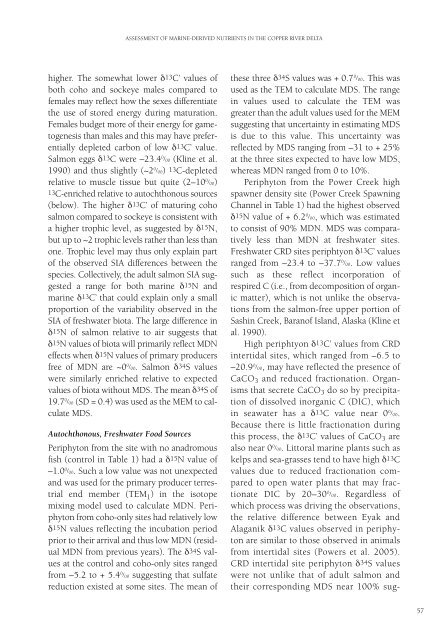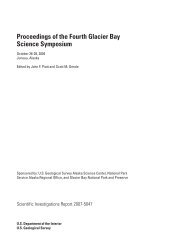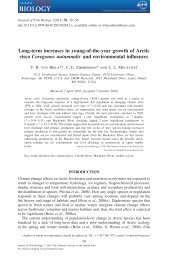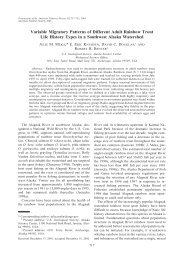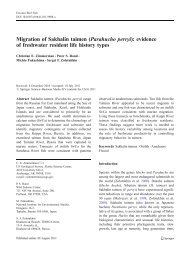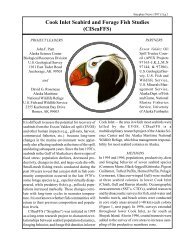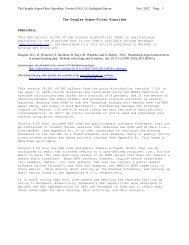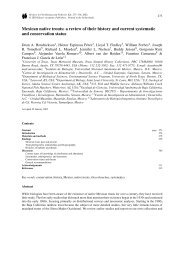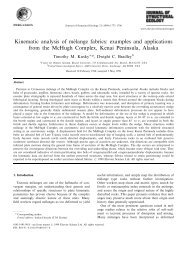Kline, T. C., C. A. Woody, M. A. Bishop, S. P. Powers, and E. E. ...
Kline, T. C., C. A. Woody, M. A. Bishop, S. P. Powers, and E. E. ...
Kline, T. C., C. A. Woody, M. A. Bishop, S. P. Powers, and E. E. ...
Create successful ePaper yourself
Turn your PDF publications into a flip-book with our unique Google optimized e-Paper software.
ASSESSMENT OF MARINE-DERIVED NUTRIENTS IN THE COPPER RIVER DELTA<br />
higher. The somewhat lower δ13C’ values of<br />
both coho <strong>and</strong> sockeye males compared to<br />
females may reflect how the sexes differentiate<br />
the use of stored energy during maturation.<br />
Females budget more of their energy for gametogenesis<br />
than males <strong>and</strong> this may have preferentially<br />
depleted carbon of low δ13C’ value.<br />
Salmon eggs δ13C were –23.4 0 / 00 (<strong>Kline</strong> et al.<br />
1990) <strong>and</strong> thus slightly (~2 0 / 00) 13C-depleted<br />
relative to muscle tissue but quite (2–10 0 / 00)<br />
13C-enriched relative to autochthonous sources<br />
(below). The higher δ13C’ of maturing coho<br />
salmon compared to sockeye is consistent with<br />
a higher trophic level, as suggested by δ15N,<br />
but up to ~2 trophic levels rather than less than<br />
one. Trophic level may thus only explain part<br />
of the observed SIA differences between the<br />
species. Collectively, the adult salmon SIA suggested<br />
a range for both marine δ15N <strong>and</strong><br />
marine δ13C’ that could explain only a small<br />
proportion of the variability observed in the<br />
SIA of freshwater biota. The large difference in<br />
δ15N of salmon relative to air suggests that<br />
δ15N values of biota will primarily reflect MDN<br />
effects when δ15N values of primary producers<br />
free of MDN are ~0 0 / 00. Salmon δ34S values<br />
were similarly enriched relative to expected<br />
values of biota without MDS. The mean δ34S of<br />
19.7 0 / 00 (SD = 0.4) was used as the MEM to calculate<br />
MDS.<br />
Autochthonous, Freshwater Food Sources<br />
Periphyton from the site with no anadromous<br />
fish (control in Table 1) had a δ15N value of<br />
–1.0 0 / 00. Such a low value was not unexpected<br />
<strong>and</strong> was used for the primary producer terrestrial<br />
end member (TEM 1 ) in the isotope<br />
mixing model used to calculate MDN. Periphyton<br />
from coho-only sites had relatively low<br />
δ15N values reflecting the incubation period<br />
prior to their arrival <strong>and</strong> thus low MDN (residual<br />
MDN from previous years). The δ34S values<br />
at the control <strong>and</strong> coho-only sites ranged<br />
from –5.2 to + 5.4 0 / 00 suggesting that sulfate<br />
reduction existed at some sites. The mean of<br />
these three δ34S values was + 0.7 0 / 00. This was<br />
used as the TEM to calculate MDS. The range<br />
in values used to calculate the TEM was<br />
greater than the adult values used for the MEM<br />
suggesting that uncertainty in estimating MDS<br />
is due to this value. This uncertainty was<br />
reflected by MDS ranging from –31 to + 25%<br />
at the three sites expected to have low MDS,<br />
whereas MDN ranged from 0 to 10%.<br />
Periphyton from the Power Creek high<br />
spawner density site (Power Creek Spawning<br />
Channel in Table 1) had the highest observed<br />
δ15N value of + 6.2 0 / 00, which was estimated<br />
to consist of 90% MDN. MDS was comparatively<br />
less than MDN at freshwater sites.<br />
Freshwater CRD sites periphtyon δ13C’ values<br />
ranged from –23.4 to –37.7 0 / 00. Low values<br />
such as these reflect incorporation of<br />
respired C (i.e., from decomposition of organic<br />
matter), which is not unlike the observations<br />
from the salmon-free upper portion of<br />
Sashin Creek, Baranof Isl<strong>and</strong>, Alaska (<strong>Kline</strong> et<br />
al. 1990).<br />
High periphtyon δ13C’ values from CRD<br />
intertidal sites, which ranged from –6.5 to<br />
–20.9 0 / 00, may have reflected the presence of<br />
CaCO 3 <strong>and</strong> reduced fractionation. Organisms<br />
that secrete CaCO 3 do so by precipitation<br />
of dissolved inorganic C (DIC), which<br />
in seawater has a δ13C value near 0 0 / 00.<br />
Because there is little fractionation during<br />
this process, the δ13C’ values of CaCO 3 are<br />
also near 0 0 / 00. Littoral marine plants such as<br />
kelps <strong>and</strong> sea-grasses tend to have high δ13C<br />
values due to reduced fractionation compared<br />
to open water plants that may fractionate<br />
DIC by 20–30 0 / 00. Regardless of<br />
which process was driving the observations,<br />
the relative difference between Eyak <strong>and</strong><br />
Alaganik δ13C values observed in periphyton<br />
are similar to those observed in animals<br />
from intertidal sites (<strong>Powers</strong> et al. 2005).<br />
CRD intertidal site periphyton δ34S values<br />
were not unlike that of adult salmon <strong>and</strong><br />
their corresponding MDS near 100% sug-<br />
57


